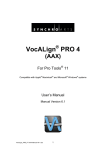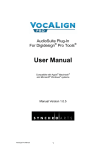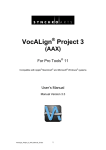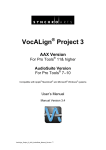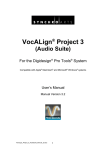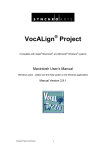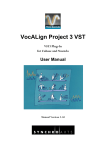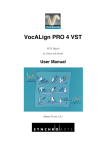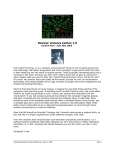Download View - Synchro Arts
Transcript
VocALign Project 3 AU Audio Units Plug-In for Logic 8 and higher User Manual Manual Version 5.0 VocALign Project AU Manual V5.doc 1 Contact Information Synchro Arts Limited 13 Links Road Epsom, Surrey KT17 3PP, UK Tel: +44 1372 811934 UK Tel: 01372 811934 Fax: +44 1372 817976 UK Fax: 01372 817976 Email: [email protected] Online Support at: Web: http://www.SynchroArts.com [email protected] © Synchro Arts Limited 1995-2013 VocALign is a registered trademark of Synchro Arts Limited. All other trademarks are the property of their respective holders. VocALign Project AU Manual V5.doc 2 End User License Agreement PLEASE READ THIS LEGAL AGREEMENT CAREFULLY PRIOR TO USING THE VOCALIGN SOFTWARE PROVIDED WITH THIS AGREEMENT. THIS AGREEMENT IS BETWEEN SYNCHRO ARTS LIMITED AND YOU. USE OF THE SOFTWARE CONSTITUTES YOUR ACCEPTANCE OF THE TERMS OF THIS LICENSE. IF YOU DO NOT AGREE TO THE TERMS OF THIS LICENSE YOU MAY NOT USE THIS SOFTWARE. INSTEAD, PROMPTLY CONTACT THE SOURCE FROM WHICH IT WAS OBTAINED FOR A REFUND AND REVOCATION OF ANY LICENSE. 1. Hardware key license. In fully authorized licensed mode, in order to function, this software requires an Authorization Code to be deposited on a hardware key (PACE iLOK USB “Smart key”). You may install this software on multiple hardware devices, but you may only use the software on one hardware device at a time, and only in connection with your properly Authorized hardware key. 2. License. The application, demonstration and other software and audio accompanying this License, whether on disc, in memory or on any other media (the ‘Software’), and the related documentation are licensed to you by Synchro Arts Limited. You may transfer all your license rights in the Software, the related documentation and a your Authorization and License to another party, provided the other party reads and agrees to accept the terms and conditions of this License. 3. Copy and use restrictions. This Software is protected by the copyright laws that pertain to computer software. The Software contains trade secrets and in order to protect them you may not decompile, reverse engineer, disassemble or otherwise reduce the software to human-perceivable form. You may not modify, adapt, translate, rent, lease or create derivative works based upon the Software or any part thereof. You may not provide use of the Software in a network, time-sharing, or multiple user arrangement. You acknowledge that no title to the intellectual property in the Software is transferred to you and that title and full ownership rights to the Software a will remain the exclusive property of Synchro Arts Limited or its suppliers and licensors. You may copy the software only to the extent necessary for backup or archival purposes in support of your use of the software. You must include all copyright and other legal notices appearing on the software in any copies that you make. 4. Circumvention of copy protection. This software includes technology designed to prevent or detect unlicensed use of the software and circumvention of this technology is prohibited. Attempts to circumvent this copy protection technology may make the software or certain features unusable or unstable, and may prevent you from updating or upgrading the software. 5. Termination. This License is effective until terminated. You may terminate this License at any time by destroying all copies and recordings of the licensed software and documentation and giving a legally binding written assurance to Synchro Arts that you have done so. This License will terminate immediately without notice from Synchro Arts Limited if you fail to comply with any provision of this License. Upon termination you must contact Synchro Arts to allow them to revoke your Software Authorization on your iLok Smart Key. 6. Educational Use. If the software is designated as specially-priced "Educational" version, it is licensed only for non-commercial use by students, faculty, and staff of an educational institution. 7. Evaluation software. If the software is designated or licensed as a “Not for Resale (NFR)” or “Trial version, you may use the software only for demonstration, testing or evaluation purposes. If the software authorization is time-limited, any rights granted to you by Synchro Arts terminate at the end of the stated time limitation. 8. Limited Warranty. Synchro Arts Limited warrants that the software, if properly authorized and used as described in the documentation which accompanies it, will perform as described in the relevant documentation. This limited warranty covers the software (and updates) for 90 days following the date of purchase and can only be extended if required by law. This limited warranty is void if failure of the Software has resulted from accident, abuse or misapplication. Any replacement Software will be warranted for the remainder of the original warranty period. This warranty gives you specific legal rights and you may also have other rights which vary by jurisdiction. 9. No Other Warranties. Except for the express warranty set forth above, Synchro Arts Limited grants no other warranties, express or implied, by statute or otherwise, regarding the software and related materials, their fitness for any purpose, their quality, their merchantability or otherwise. The liability of Synchro Arts Limited under the warranty set forth above shall be limited to the amount paid by the customer for the product. In no event shall Synchro Arts Limited or its authorized distributors be liable for any special, consequential or other damages or breach of warranty. 10. Severability. In the event any provision of this Agreement is determined to be invalid or unenforceable, it shall be adjusted so as to best reflect the intent of the parties to the maximum extent possible, and the remainder of this agreement shall be valid and enforceable to the maximum extent possible. 11. Entire Agreement. This Agreement is the entire understanding between the parties with respect to the subject matter hereof and replaces any previous discussion and/or agreement regarding such subject matter. No amendment to or modification of this License will be binding unless in writing and signed by Synchro Arts Limited. 12. Governing Law. This Agreement shall be interpreted and enforced in accordance with English law and the English courts shall have jurisdiction to determine any dispute. VocALign Project AU Manual V5.doc 3 Table of Contents End User License Agreement............................................................3 A) INTRODUCTION TO VOCALIGN...............................................................6 1. What is VocALign?..........................................................................6 2. How does VocALign work?.............................................................6 3. How can VocALign help?................................................................7 4. Working without VocALign.............................................................7 5. Working with VocALign...................................................................7 B) APPLICATIONS..........................................................................................8 C) SOFTWARE INSTALLATION AND AUTHORIZATION..............................9 1. Installation........................................................................................9 2. Trial and Full Licenses....................................................................9 3. Software authorization....................................................................9 4. What is iLok.com? ........................................................................10 5. How to install a VocALign Project AU License from iLok.com onto an iLok Key............................................................................................10 6. How to authorize VocALign Project AU with your iLok Key.....11 7. iLok Support...................................................................................11 D) SOFTWARE INSTALLATION AND AUTHORIZATION............................12 1. Installation......................................................................................12 2. Demonstration, Trial and Full Licenses.......................................12 3. Software authorization overview..................................................13 4. More information on iLok.com ....................................................13 5. How to install a VocALign License from iLok.com to an iLok Key...................................................................................................................14 6. How to authorize VocALign with your Licensed iLok Key........15 7. iLok Support...................................................................................15 E) TUTORIAL AND OVERVIEW OF OPERATION.......................................16 F) BASIC OPERATION..................................................................................23 G) FURTHER DETAILED OPERATIONS AND TIPS....................................25 1. General Operations........................................................................25 2. Description of Alignment Settings...............................................27 H) TROUBLE SHOOTING..............................................................................28 VocALign Project AU Manual V5.doc 4 Important Notes In this manual, "VocALign Project 3 AU Plug-In for Logic" will sometimes be referred to simply as "VocALign Project 3" or “VocALign”.. Technical specifications This program is compatible with Apple Logic 8 or higher software running on Mac OS 10.4.9 or later (Logic 8), Mac OS 10.5.7 or later (Logic 9).. VocALign Project 3 processes audio with sample rates up to 192 kHz. Acknowledgements Special thanks goes to our beta testers and the Apple Logic team for their help and support. Thanks to Steve Cooke for providing the English voices in the demonstration audio. VocALign is developed and sold under license from Wordfit Limited. VocALign Project AU Manual V5.doc 5 A) Introduction to VocALign 1. What is VocALign? VocALign is a process that edits the timing of one audio signal to match another – automatically. TIP: To use VocALign Project 3 effectively, the audio editor should understand the basic components of the processing. 2. How does VocALign work? VocALign works by applying varying amounts of time stretching or compression to one signal (called the "Dub") to make its energy peaks and troughs align in time with a “Guide” signal. It does this in 3 main steps. VocALign Block Diagram Guide Audio SPECTRUM ANALYSIS Dub Audio TIME ALIGNMENT ALGORITHM TimeWarping PATH AUDIO EDITING TimeAligned Dub Audio SPECTRUM ANALYSIS 1. VocALign analyses the Guide and Dub audio signals using identical Spectrum Analysers to produce time-varying energy patterns. 2. Then it uses advanced pattern recognition techniques to examine the energy patterns and determine the best way to “warp” time to align the Dub energy to the Guide energy. The Time-Warping Path describes the best time-distortion of the Dub for matching to the Guide. It is important to remember this. 3. The Path is fed to an Audio Editing processor that time-compresses and expands the Dub audio to create the aligned version based on the Path. It is this edited version of the Dub that is returned to the audio editing software for the desired use. Note: In the above diagram, the audio signal name’s colours match those in the VocALign Project 3 screen. VocALign Project AU Manual V5.doc 6 3. How can VocALign help? If you are a dialogue editor needing to lip-sync vocals, or a music editor needing to tightenup lead or backing vocals, instrumental tracks, or a number of other alignment tasks, then VocALign will help you! 4. Working without VocALign A dubbing session, for film post production, or music production, begins with a guide track. Then the voice-over artist, singer, or musician will dub this as closely as possible. Because humans are not machines, they will not be able to get exactly in time with the Guide. This is generally not acceptable for lip-syncing, nor for double-tracking of vocals or instruments. Often, the next step is to loop-record the more tricky sections individually, but this can break-up the natural flow of the line. Lastly, the editor will use a digital audio editor to cut and nudge individual sections of the new recordings into time with the Guide. The above process can take many hours for both the artist and the editor. 5. Working with VocALign The above process becomes a simple matter of getting the artist to concentrate on creating a great performance, and not worry about the fact that it may drift in and out of exact sync with a previous performance. VocALign can then be used to adjust the timing by automatically applying the required amount of varying time-stretching and compression to allow the Dub to take on the same timing as the Guide. This saves studio time, saves artists time and improves the quality of your results. Most importantly, you allow your artists to produce their best performances, free from the rigidity normally associated with dubbing. VocALign Project AU Manual V5.doc 7 B) Applications VocALign was originally designed for Lip Syncing replacement dialogue for Film and Video post-production but it has been adapted to work successfully in the following applications: Syncing replacement dialogue in Post Production for Film and Video. Double-tracking vocal parts or instrumental parts Tightening backing singers with one another, or with the lead vocal Tightening backing instrumental tracks Sync’ing a drum machine audio-output to a real drummer (or vice versa) Giving a dubbed vocal the timing of a “live” vocal performance, Changing the voice or even sex of a singer or actor’s performance. Replacing the vocals in a music video shoot with a production track, achieving perfect lip-sync. Foreign Language Dubbing VocALign Project AU Manual V5.doc 8 C)Software Installation and Authorization 1. Installation If you have not already done so, you can download VocALign from http://www.synchroarts.com/downloads Double click the disk image (.dmg) file that you downloaded to mount the disk image on the desktop. Next, double click the VocALign pkg to install the VocALign software. 2. Demonstration, Trial and Full Licenses VocALign can run (fully functional) in one of 3 Licensed Modes: (a) Trial Mode – requires an iLok Trial License installed in a iLok Smart Key to run for a Limited Period after launch. (b) Demonstration Mode – runs immediately on a “built-in” Demonstration License for a limited time after launch. This mode does not need an iLok Smart key. (c) Full License Mode – requires an iLok “Full” license installed in an iLok Smart Key to run without time limits. NOTES: Different versions of the VocALign plug-in will run either in the Demonstration or Trial Modes without having to purchase a license. The user will be informed, before downloading the software, if the Trial Modes is built into the software being downloaded. Software that runs a Demonstration mode does not need an iLok account or Smart key while the demonstration mode is active, but will need both to run a purchased license in Full mode.. If the software is using a Trial or has purchased a license to run in Full Mode – the user will require both an iLok “Smart Key” (described below) and an account on iLok.com. The rest of this Chapter provides more details on each of these authorization Modes and on the iLok authorization system. VocALign Project AU Manual V5.doc 9 3. Software authorization overview VocALign uses the iLok system for authorization. For Trial and Full Licenses, the VocALign licenses are downloaded from an iLok.com Account and installed on one of the USB ‘smart Keys’ pictured below. Before you can download a license, one must be deposited into your iLok.com Account. There are two main methods for getting VocALign licenses from Synchro Arts into your iLok.com Account. Synchro Arts can deposit a VocALign iLok license directly into your iLok.com account (if we are told your account USER ID). This can occur if you purchase from Synchro Arts store or dealers. Or, You can obtain a Trial or Full License Code from the Synchro Arts website or from an authorized Synchro Arts Software Dealer. The License Code must be redeemed (i.e. traded in) on iLok.com for a VocALign License that is deposited into your iLok.com account. Once your iLok.com account contains a VocALign license, you can log in and download the license to your iLok Key. When your iLok Key contains a VocALign license, plug the Key into a USB port on the computer that will be running your copy of VocALign software and any host application. You will then be able to launch and run the VocALign software in an authorized mode. iLok Keys can hold licenses for a large number of protected software products. You can also have licenses from Synchro Arts and other software vendors on the same iLok. 4. More information on iLok.com The www.iLok.com website (provided by PACE) lets you create a personal account which is used to manage your software licenses. If you don’t have a user account you will need to create one before you can authorise your VocALign Trial or Full software. On www.iLok.com, you can receive new licenses from software publishers such as Synchro Arts, see what licenses are on your iLok Keys, register your licenses and move your licenses between iLok Keys. Using software available from iLok.com, you can transfer licenses from VocALign Project AU Manual V5.doc 10 iLok.com to your computer and also identify the iLoks you currently have connected to the USB port on your computer. Synchro Arts may also use your iLok.com account to provide your license and give you technical support. First time using iLok? If this is the first time you have used iLok you may need to download and install the iLok extensions and drivers from http://www.ilok.com/ Obtaining your Trial or Full License 1. If you haven’t done so, you need to inform Synchro Arts (or your software dealer) of your iLok.com account User ID. (This is normally done at the same time you obtain a Trial license or purchase a Full License.) 2. Synchro Arts will deposit a license into your iLok.com account and notify you. 3. Alternatively, you might have originally received an iLok Trial or Full License Code which you must redeem on iLok.com in order to obtain your iLok license in your account. Failure to keep your iLok.com account up to date may result in delays in providing you with services or other support. Trial Mode Once you have obtained and installed a Trial license, VocALign will run in a fully functional Trial mode for the number of days shown in any email you received with a Trial License Code.. At the end of the Trial, if you wish to purchased a license, either go to the Synchro Arts online store by clicking here or contact a Pro Audio Dealer selling Synchro Arts products. 5. How to install a VocALign License from iLok.com to an iLok Key 1. Insert the iLok Key into an available USB port on your computer and ensure its indicator light is lit. 2. Log in to your account at www.iLok.com. 3. On iLok.com, if you have received notification from Synchro Arts or iLok.com that your electronic license has been deposited, then your authorization is available for transfer. Your iLok.com account will display a notice saying ‘You have licenses’. Select that link to start the transfer. 4. The next page on iLok.com will display the pending licenses available for download, along with the name of the application to which it relates, the manufacturer, the type of authorization (Trial, NFR (Not For Resale), or License), the date the authorization was deposited, and any date when the authorization will no longer be available for download from the server. VocALign Project AU Manual V5.doc 11 5. Before an authorization transfer can take place, synchronize your iLok Key with iLok.com. 6. Once you have synchronized your iLok, select the authorization(s) you wish to transfer to your iLok. If you have multiple iLoks connected to your computer, it is important to select the correct iLok as the destination to which you want an authorization to be transferred. 7. On iLok.com, click Download Licenses to begin the process. When the transfer finishes you will be asked to confirm completion, indicating that the transfer was successful. 6. How to authorize VocALign with your Licensed iLok Key If you followed the above procedure correctly, authorizing VocALign is simply a matter of inserting the iLok Smart Key that contains the correct license into the computer that you are using with your host audio editing software. Once that iLok Smart key is inserted, you will be able to use VocALign.. See the next chapter for details on how to do this. Reauthorizing VocALign if the iLok Key is removed If you subsequently try to run VocALign without the iLok Key inserted into your computer you will receive a warning message. Press Retry (or, if different version, press Buy) and reinsert the iLok Key containing the relevant license. The software will be reauthorized. WARNING: Do not remove the iLok from your computer while you are using VocALign. If the iLok is removed VocALign will stop working and you might lose your work. 7. iLok Support For further information on iLok, go to www.iLok.com. VocALign Project AU Manual V5.doc 12 D) Tutorial and Overview of Operation To learn to use the basic functions of VocALign Project 3 only takes a few minutes, but for quickly getting the best understanding we strongly recommend that you first follow the brief Tutorial below which uses prepared audio examples. In this Tutorial, once we load the prepared Tutorial Project in Logic, we will explain how to: a) Select the Guide and Dub audio in Logic that will be processed in VocALign. b) Transfer the Guide and Dub audio into the VocALign plug-in c) Use VocALign to create an Aligned (synchronized) Dub and audition it d) Return the Aligned Dub audio to Logic 1. Obtain the Tutorial Project and Audio The Logic Project for the Tutorial session can be found by going to www.synchroarts.com/downloads On the Downloads page, locate the Tutorials and click on the following link to download the Tutorial Project to a hard disk: VocALign Logic Project The copied folder should contain the file and folder shown below. The folder VocALign AU Tutorial should contain the following audio files and Project: VocALign Project AU Manual V5.doc 13 2. Open the VocALign AU Tutorial project in Logic. (Logic 8 is shown below) 3. In Logic, add “VocALign Project AU” as an Insert on the DUB track by selecting the folders: “Audio Units” and then “Synchro Arts Limited” as shown below. VocALign Project AU Manual V5.doc 14 The VocALign Project AU window should appear as shown below: 4. In the VocALign window set the side chain input to the GUIDE track as shown below. 5. In Logic, select the part of the project you want to process using Logic's Location Indicators – as shown below. VocALign Project AU Manual V5.doc 15 Tips A. Setting Logic in Grid mode will make it easier to put the aligned audio at exactly the right location (at the same start as the Dub). B. Make sure you select everything you want VocALign to process in Step 7. C. The Guide and Dub audio should be approximately in the same place. 6. In VocALign, click the “Capture Audio” button and make sure its “Ready” light goes green as shown below. 7. In Logic, play your selected Guide and Dub audio (press the space bar). 8. When playback stops, waveforms (as shown below) should appear in the VocALign window showing the selected Guide and Dub audio. VocALign Project AU Manual V5.doc 16 9. In VocALign, If required, adjust the start or end of the audio by clicking the waveform where the change of colour occurs and dragging the cursor. Adjusting end of Guide audio Adjusting end of Dub audio Tip Try to ensure the start of the audio selection is in “silence” about 0.25 seconds before the waveform energy appears and try to ensure the end of the selected audio is at the desired stopping point. 10. In VocALign, make sure the drop down menu for setting the Alignment control is showing “Normal Flexibility”. 11. Click “Align”. A trace will appear in the Guide window showing the Aligned energy of the Dub superimposed on the Guide energy as shown below. Note that the small speaker icon in the lower right corner is red, indicating that the audio has not been processed and cannot be played back. VocALign Project AU Manual V5.doc 17 12. In VocALign, click “Edit”. The edited (aligned) audio will be created and written to disk and the “playback ready” (speaker) indicator will change to green as shown below. (Nothing else visible happens). 13. In Logic, select Play (space bar). You should hear the Guide and Aligned audio played in sync together. In Logic, you can adjust the section being played back. 14. You can listen to the audio before alignment by turning the VocALign “Bypass” switch on as shown below and they press Play in Logic. Be sure to turn Bypass off if you want to use the Aligned audio. 15. Lastly, you can create an audio file from the Aligned Dub: In Logic, hold down “Control” key and click inside the Dub region. In the menu that is displayed (shown below) select “Export as Audio File” Then save the selected audio as a named file. VocALign Project AU Manual V5.doc 18 16. The new file can then be dragged from the Bin back to the Logic timeline. Note: If Logic is in Grid mode, then the waveform can be placed with sample accuracy TIP DO NOT Save the "VocALign Project 3 Tutorial PT" session over the original Tutorial session when exiting Pro Tools, so it can be used again. VocALign Project AU Manual V5.doc 19 E) Basic Operation 1. List of Screen Contents and Controls 1) Bypass Button: If OFF, VocALign plays and transfers Aligned Dub audio. If ON, VocALign plays and transfers original Dub audio. 2) Capture Audio Button: Arms VocALign to receive Guide and Dub audio from Logic during play pass. 3) Side Chain Selector: User selects the Logic track containing the Dub audio. 4) Help Button: Click to access this manual. 5) Display Start Time and time offsets. 6) Aligned Audio Trace: A representation of the energy of the new Aligned signal. 7) Guide Energy: A profile of the energy of the Guide signal in time 8) Guide Start Point Selector: Adjusts processing start. (corresponding End Point Selector not shown) 9) Dub Start Point Selector: Adjusts processing start. (corresponding End Point Selector not shown) 10) Dub Energy: A profile of the energy of the Dub signal in time VocALign Project AU Manual V5.doc 20 11) Scroll Bar Use slider to move waveform position in window in conjunction with controls in 16. 12) Align Button: Click this to generate the Aligned audio energy trace in Guide Window (does not create aligned audio). 13) Filter Button: Click to only analyse the audio through a filterbank and display the energy from the band from 500 to 1000 Hz. 14) Overview Window: Shows multiple captured regions and clicking waveform selects the Dub and Guide waveforms to be processed. 15) Unselected Guide Waveform: Guide audio that will not be processed 16) Unselected Dub Waveform: Dub audio that will not be processed 17) Overview waveform display scrolling: Slide to move display 18) Selected Guide Waveform: Guide audio that will be processed. 19) Selected Dub Waveform: Dub audio that will be processed. 20) VocALign Settings: Controls the characteristics of the alignment processing. 21) Edit Button: Click to generate Aligned audio. (24) will indicate when done. 22) Delete Button: Click to remove all waveforms from VocALign. 23) Overview waveform display scaling: Slide to zoom in and out 24) Editing Complete Indicator: If green, edited (Aligned) audio is processed and ready for playback. 25) Selected waveform display scaling: Slide to zoom in and out 26) Energy Scale: Shows range of display. VocALign Project AU Manual V5.doc 21 F) Further Detailed Operations and Tips 1. General Operations In this section, we describe additional operational details with reference to the VocALign Project 3 window shown previously and in additional figures following in use with the Tutorial Audio. 1) In Logic, we start with a session in which there is "Guide" (original) audio contained in a on one track and a "Dub" (replacement or new) audio in a second track. 2) Highlight the desired portion of the Guide and Dub audio regions for processing. There can be any given region or multiple regions. Your selection can begin and end in the middle of a region. TIP: Try to capture up to around 0.25 to 0.5 seconds of “background” or “leader” audio at the beginning of your Guide audio selection. (This will assist the process to set the noise floor levels and generally allow better alignment at the start of the signal). Note: In the current version of VocALign Project 3, the selected audio must be shorter than 120 seconds and longer than 0.25 seconds. NOTE: The Dub does not have to start at the same time of the Guide. In other words, the timecode position of the Dub is not used. The Guide's timecode is important and so is the amount of “background” captured before the Guide and the Dub. TIP: Try to leave as much or very slightly more “background” audio before the Dub signal starts than for the Guide. 3) The user can optionally perform several operations on the energy display waveform itself before Alignment :a) The start and end boundary of the selected regions can be modified by positioning the cursor (arrow) at either end of the audio selections, holding down the mouse and dragging the dotted line that appears. Where the waveform turns grey indicates unselected audio energy. Releasing the mouse will leave the boundary indicator in place. VocALign Project AU Manual V5.doc 22 b) Clicking at the boundary and dragging will leave a dotted line in place at the previous boundary and create a second line to show the new cursor position. Moving the cursor by dragging will allow a new boundary position to indicate a new energy start point. This is shown above. This operation affects the processing. c) The display can be scrolled with the scroll bars to examine the captured waveforms. d) The Scale control can be used to zoom in or out of the waveform to see more (+) or less (-) detail in the display windows at one time. e) Choose an appropriate setting (e.g. if the Dub is very long compared to the Guide, try "Maximum Compression"). 4) After clicking Align, visually inspect the results in the Guide window. The peaks and troughs of the yellow (Aligned Dub) energy trace should line up generally with those of the Guide as in the figure below. 5) If the alignment looks satisfactory, generate the Aligned Audio by pressing Edit. This creates the Aligned audio. 6) A “shortcut” is to simply press Edit after Capturing the audio. 7) Preview the results by using the Logic Play controls. 8) If the alignment is satisfactory, transfer the edited audio to Logic as described in the Tutorial. 9) If the alignment does not look or sound satisfactory, there are a few options: a) Select another Setting or Alignment mode (which will clear the aligned trace), click Align again, and examine the results. b) Adjust the "leader" audio before the start of the Guide and Dub to be roughly equivalent with the Dub "leader" being somewhat longer. c) Adjust the “end” of the Guide or Dub (see section ???) d) Reselect and recapture the Guide or Dub audio in Logic, if the selection is thought to be causing the problem. VocALign Project AU Manual V5.doc 23 2. Description of Alignment Settings The user has control over the Alignment Settings, which greatly affect how the alignment performs. Clicking to the right of the “Alignment Setting” window will bring up the Settings Pre-sets , from which the user can select which Setting is active. The main Setting characteristics are described in the chart below. Setting Main characteristics Low Flexibility Alignment is not very flexible, sound quality may be best. Normal Flexibility (Default): Recommended trying this first as it works best in most cases. High Flexibility Alignment is the most flexible of the Basic Settings. Maximum Compression Tries to match the Guide by time compressing the aligned audio as much as possible. Maximum Expansion Tries to match the Guide by time-expanding the aligned audio as much as possible. 3. Special Operations a) “Latching” To align just the start of the Dub with the Guide (and leave the rest of the Dub unprocessed), use the Guide End Point Selector to use only select 0.25 to 1.0 second of the Guide audio for processing and keep the Dub signal full length. b) Reverb tails To stop the end of a Dub from being stretched to wrongly "fit" to a noisy or reverberant Guide, stop the end of the Guide for processing to be 0.25 to 1.0 second before the Guide signal of interest ends and use the entire Dub . VocALign Project AU Manual V5.doc 24 G) Trouble Shooting Some commonly occurring problems are listed here: Problem: “VocALign Project does not appear in the Audio Units menu.” Solution: Mac users: Check that the file "VocALign Project 3” has been copied to the correct Plug-Ins folder. Problem In Logic when selecting the following menu: Logic Pro>Preferences>Audio Units Manager VocALign is not displayed in the list. Solution Try selecting ‘Reset and Rescan Selection’ Further help and advice can be found in the Support pages on the Synchro Arts website at: http://www.SynchroArts.com VocALign Project AU Manual V5.doc 25



























